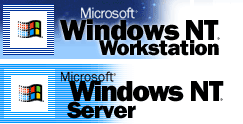About Windows NT
 Windows NT is a Microsoft
Windows personal computer operating system designed
for users and businesses needing advanced capability.
NT's technology is the base for the Microsoft
successor operating system, Windows 2000. Windows NT
(which may originally have stood for "New
Technology," although Microsoft doesn't say) is
actually two products: Microsoft NT Workstation and
Microsoft NT Server.
Windows NT is a Microsoft
Windows personal computer operating system designed
for users and businesses needing advanced capability.
NT's technology is the base for the Microsoft
successor operating system, Windows 2000. Windows NT
(which may originally have stood for "New
Technology," although Microsoft doesn't say) is
actually two products: Microsoft NT Workstation and
Microsoft NT Server.
The Workstation is designed for users, especially business users, who need faster performance and a system a little more fail-safe than Windows 95 and Windows 98. The Server is designed for business machines that need to provide services for network-attached computers. The Server is required, together with an Internet server such as Microsoft's Internet Information Server (IIS), for a Windows system that plans to serve Web pages.
Windows NT Workstation: Microsoft says that 32-bit applications run 20% faster on this system than on Windows 95 (assuming both have 32 megabytes of RAM). Since older 16-bit applications run in a separate address space, one can crash without crashing other applications or the operating system. Security and management features not available on Windows 95 are provided. The Workstation has the same desktop user interface as Windows 95.
Windows NT Server: The NT Server is probably the second most installed network server operating system after Novell's NetWare operating system. Microsoft claims that its NT servers are beginning to replace both NetWare and the various Unix-based systems such as those of Sun Microsystems and Hewlett-Packard. NT Server 5.0. essentially became what was renamed Windows 2000. Notable features of the Windows 2000 products are:
- A fully-customizable administrative console that can be based on tasks rather than files, applications, or users
- A new file directory approach called Active Directory that lets the administrator and other users view every file and application in the network from a single point-of-view.
- Dynamic Domain Name Server (DNS), which replicates changes in the network using the Active Directory Services, the Dynamic Host Configuration Protocol (DHCP), and the Windows Internet Naming Service (WINS) whenever a client is reconfigured.
- The ability to create, extend, or mirror a disk volume without having to shut down the system and to back up data to a variety of magnetic and optical storage media.
- A Distributed File System (DFS) that lets users see a distributed set of files in a single file structure across departments, divisions, or an entire enterprise.
- Close integration with and support for Microsoft's Message Queue Server, Microsoft Transaction Server, and Internet Information Server (IIS).
